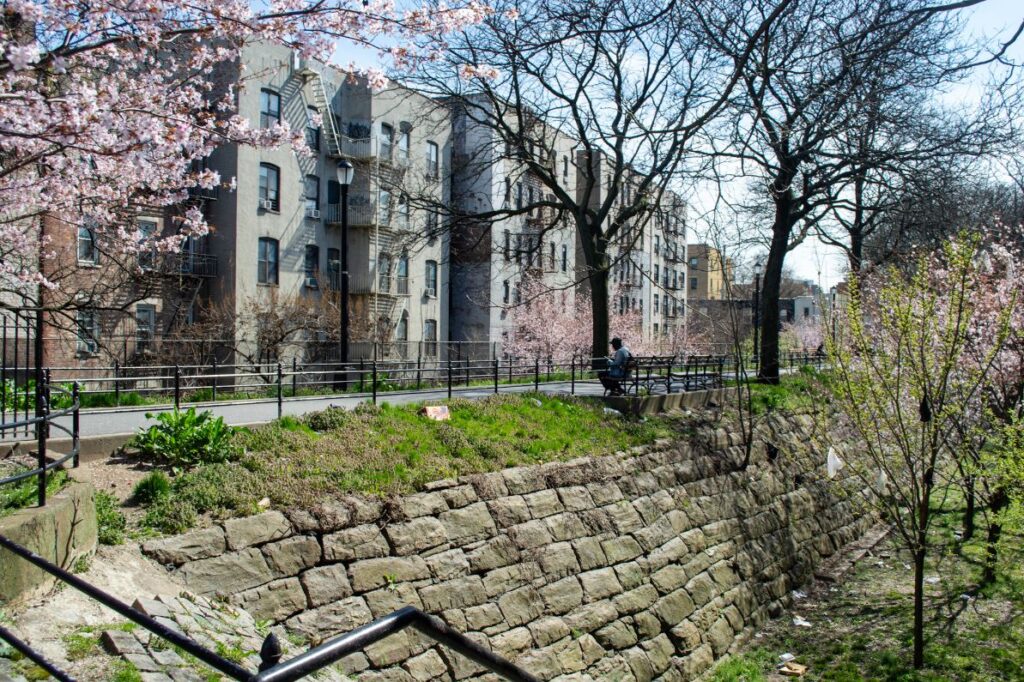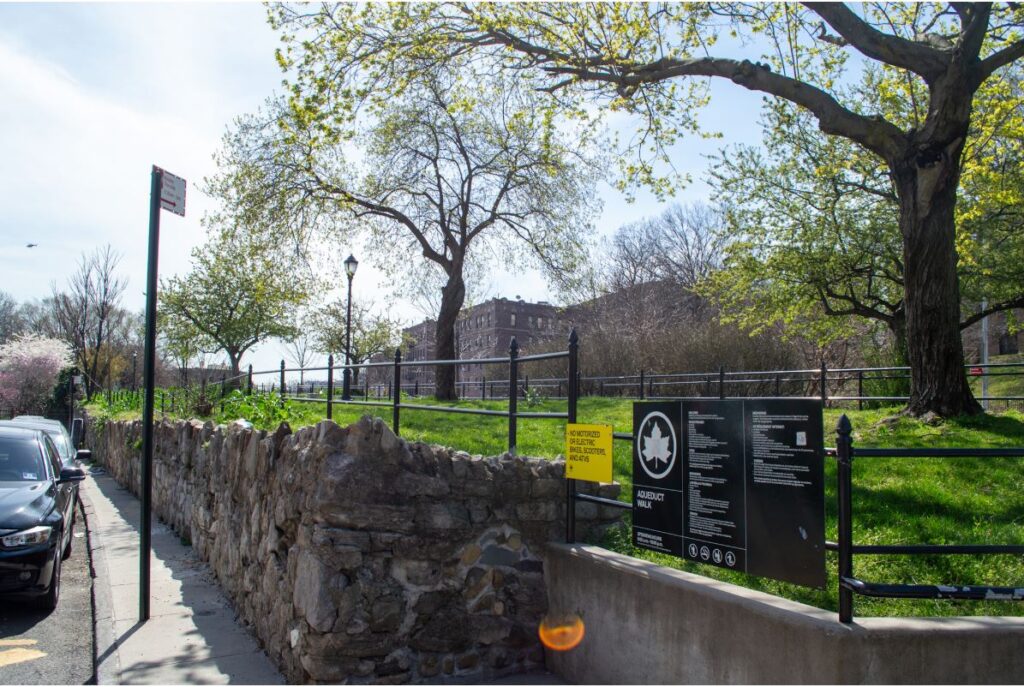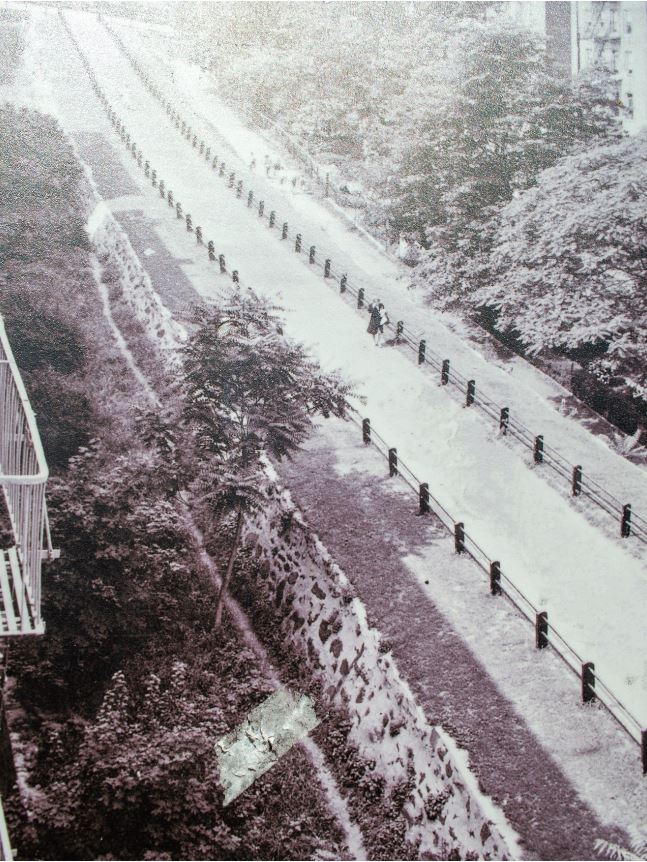
Photo courtesy of New York City Landmarks Preservation Commission (LPC)
The New York City Landmarks Preservation Commission (LPC) celebrated the 50th anniversary of scenic landmarks in New York City with a unanimous vote to designate Old Croton Aqueduct Walk, located in University Heights, as The Bronx’s first scenic landmark, and the twelfth scenic landmark designated citywide. The vote and announcement, which as reported, took place on April 16, marks 50 years to the day since the commission designated Central Park as New York City’s first scenic landmark on April 16, 1974.
Landmarks Preservation Commission Chair Sarah Carroll, “Old Croton Aqueduct Walk began as an engineering marvel that revolutionized our city’s infrastructure and helped power its economic rise, but has remained central to our quality of life as ‘the Bronx’s High Line,’ an idyllic greenway and urban oasis for local residents for nearly two centuries.”
She added in part, “I’m thrilled that the Commission has chosen to designate Old Croton Aqueduct Walk as The Bronx’s first scenic landmark. My thanks to both the NYC Parks Department and the local Bronx community for their stewardship and long-standing support of this treasured historic site.”
Old Croton Aqueduct Walk is a 4.9-acre linear park located along Aqueduct Avenue between West Kingsbridge Road and West Burnside Avenue, and according to City officials, features a public walkway built on top of the Old Croton Aqueduct, a historic water system constructed between 1837 and 1842 that brought the first direct water supply to New York City.
They said the aqueduct provided a crucial source of water for city residents at a time of rapid population growth and is credited with allowing New York City to continue to develop into the economic capital of the United States in the 19th century.
More than just a citywide asset, City officials said the Old Croton Aqueduct held additional benefits for the neighborhoods that surrounded it. They said that long before the City created the High Line on an abandoned elevated train viaduct on Manhattan’s West Side, The Bronx’s Aqueduct Walk offered a lush green swath of accessible public recreational space built atop the aqueduct’s stone embankments, a linear trail that connected multiple Bronx neighborhoods.
They said that almost immediately after Old Croton Aqueduct opened, its pedestrian trail became a beloved public space, drawing area residents who enjoyed walking the scenic path, including famed author, Edgar Allan Poe. LPC officials said that in 1930, Aqueduct Walk officially became part of the NYC Parks Department, and the agency has made many upgrades in the years since, including seating areas, playgrounds, and lighting, which have improved public access while maintaining the walk’s historic integrity and scenic beauty.

Photo courtesy of New York City Landmarks Preservation Commission (LPC)
Norwood News has reported over the years on the local community’s ongoing efforts, together with the City Parks Foundation / Partnership for Parks, to revitalize the area, which at one point was plagued by open drug use and discarded needles.
Sharing news of the vote with her partners and residents, Pilar Maschi, senior catalyst organizer with the City Parks Foundation / Partnership for Parks, said, “It was a Unanimous Vote!” What a victory for The Bronx and the Aqueduct Walk community! The first scenic landmark for the Bronx!!” Thanking Norwood News for highlighting the community’s work on the effort, she added, “Amazing achievement with many hands on deck!!!” Local resident, Myrna Calderon, a member of the Friends of Devoe Park group, agreed, saying the news was “amazing.”
The news was also welcomed by Bronx Borough President Vanessa L. Gibson, who delivered her State of the Borough address two days after the vote, on April 18. “Aqueduct Walk is a cherished public park that sits atop the historic Old Croton Aqueduct and stands as a testament to the enduring marvel of engineering and the resilience of community spirit,” she said.
“The significance of Aqueduct Walk to the fabric of The Bronx cannot be overstated. Since the early 20th century, the community has fought to safeguard this space, recognizing its pivotal role in our borough’s history,” she added. “[..] Aqueduct Walk is receiving the scenic landmarking it deserves, reaffirming our dedication to preserving this space. I want to thank LPC Chair Sarah Carroll and the Commission for the preservation of this important site and commitment to ensuring that the Bronx’s rich history, diverse narratives, and the contributions of all its residents are celebrated and preserved for generations to come.”
For her part, NYC Parks Commissioner Sue Donoghue said in part, “Over the years, we’ve worked to improve amenities along the walk while maintaining its historic character. We’re grateful to LPC for this designation, as well as local elected officials for their support, and community members who have played an essential role in helping to care for this important public space.”
LPC officials said that when it was completed, the Old Croton Aqueduct was the solution to New York City’s growing environmental and public health concerns linked to issues with its water supply alongside a rapidly increasing population. They said work on the aqueduct system and its related structures, including the High Bridge, designated a New York City landmark in 1970, began in the spring of 1837 and took five years to complete.
Once open, they said the 41-mile-long aqueduct carried 45 million gallons of water daily to the city from a reservoir in Croton, New York. They said the original water system was covered with earth and stone embankment walls, and sloped downwards along its length, using only gravity to carry the water, an innovative design that allowed the city to use the vast water supply of the Croton River without relying on expensive hydraulic pumps.
LPC officials said Old Croton Aqueduct was a success from its first day, providing fresh water for drinking and bathing, as well as for other aspects of city life like street cleaning and firefighting. They said it was so successful, in fact, that the city’s new desire for fresh water quickly exceeded all expectations, outpacing the aqueduct’s capabilities and necessitating the construction of a second aqueduct, known as the New Croton Aqueduct, which opened in 1890 and would carry enough water to keep up with New York City’s expanding population.
They said with New Croton Aqueduct handling New York City’s water needs, Old Croton Aqueduct was taken out of service in 1955. They added that though it is no longer part of New York City’s water supply infrastructure, the trail that runs along Old Croton Aqueduct’s embankment has continued to play a central role for the surrounding community and enjoyed strong community support. They said local Bronx residents fought twice in the early 20th century to preserve it as a public space, first halting plans for a trolley line alongside the path and later blocking efforts to sell the land for development.

Photo courtesy of NYC Parks
They said Aqueduct Walk came under NYC Parks stewardship in 1930, and the agency commissioned noted landscape architect Gilmore D. Clarke to design the unique linear park, adding new walls, railings, lawns, trees, and play areas. Completed in 1940, they said NYC Parks has since made other additions and upgrades including basketball courts, playgrounds, and seating areas, maintaining the historic features of the Old Croton Aqueduct, while ensuring the park continues to serve as a beloved public space for local Bronx residents.
Old Croton Aqueduct Walk is New York City’s 12th scenic landmark citywide. LPC officials said that when the Landmarks Law was enacted in 1965, it did not originally include the scenic landmark category; the amendment allowing city-owned public open spaces or other landscape features to be designated as scenic landmarks was approved later, in December 1973, and the first official scenic landmark, Central Park, followed a few months after that, in April 1974.
They said that in the 50 years since Central Park was designated, the type of sites approved as scenic landmarks has evolved. They said while the first sites designated represented the city’s primary formal public parks like Bryant Park and Grand Army Plaza, the list of scenic landmarks soon expanded to include small special parks and parkways such as Brooklyn’s Ocean and Eastern Parkways.
They said that with its most recent scenic landmark designations, LPC has applied a more inclusive perspective on cultural significance, recognizing the important role that parks play in city life.They said in designating the Coney Island (Riegelmann) Boardwalk as a scenic landmark in 2018, LPC highlighted the democratic ideals that inspired its creation – to provide seaside access for all New Yorkers – as well as the cultural significance it has gained since as a result of its own success, and recognized that the boardwalk must continue to meet goals and requirements for resiliency within a coastal flood zone.
They said the latest scenic landmark, Old Croton Aqueduct Walk, also reflects this more inclusive perspective. They added that identified as part of a comprehensive borough-wide survey update of the Bronx, conducted by a dedicated LPC research team, its designation is a direct outcome of that survey effort as the agency continues to prioritize and advance designations in areas less well represented by landmarks.
Local City Council Member Pierina Sanchez (C.D. 14), who participated in the clean-up efforts of the Aqueduct Walk, said in part, “For New York City, the Old Croton Aqueduct Walk serves as a timeless bridge between past and present, while for District 14 residents, its long, uninterrupted path can offer a peaceful, meditative recreational space.”
She added, “The Aqueduct Walk is more than a pathway; it is the geographic spine of our community, connected to a deep history and our present identity. Completed in 1842, the Aqueduct was constructed by immigrants and stands as a testament to their enduring contributions. In the face of the breadth of challenges we face today, landmark designation can breathe life into the historic path, help us to secure resources for its improvement and the preservation of its cultural significance.”

Photo by Pilar Maschi, Partnership for Parks
Officials from LPC, a mayoral agency responsible for protecting and preserving New York City’s architecturally, historically, and culturally significant buildings and sites, concluded, saying that Old Croton Aqueduct Walk is a remarkable multi-layered scenic landmark – notable for its historical and engineering significance, as well as for its community impact and the passionate affinity and advocacy it has inspired across generations of local Bronx residents.
News of the historic Bronx designation comes on the heels of the announcement, as reported, that Bronx Community College’s Gould Memorial Library recently won the 2024 Lucy G. Moses Preservation Award.
With the addition of Old Croton Aqueduct Walk, below is the list of the 12 New York City scenic landmarks, in order of designation:
- Central Park (1974)
- Grand Army Plaza (1974)
- Bryant Park (1974)
- Ocean Parkway (1975)
- Verdi Square (1975)
- Prospect Park (1975)
- Eastern Parkway (1978)
- Riverside Park and Riverside Drive (1980)
- Fort Tryon Park (1983)
- Morningside Park (2008)
- Coney Island (Riegelmann) Boardwalk (2018)
- Old Croton Aqueduct Walk (2024)




